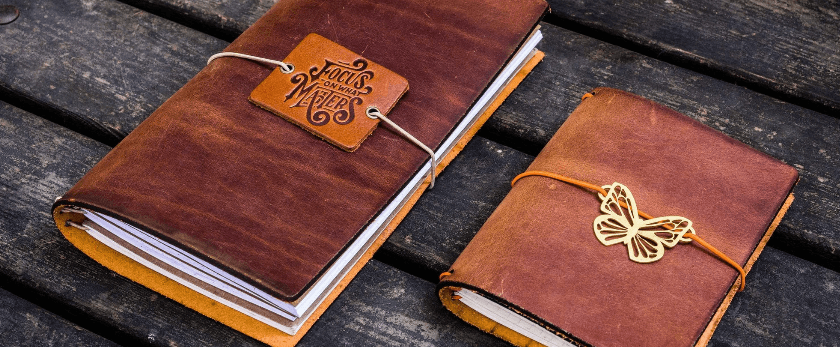Leather journals are a popular item for many people, whether it's for writing, sketching, or keeping track of daily tasks. However, the production of leather has a significant impact on the environment, from the use of chemicals in tanning to the disposal of animal waste. Fortunately, there is a more eco-friendly option – making your own leather journal at home. In this article, we will discuss why traditional leather journals are bad for the environment, the benefits of making your own, and provide a step-by-step guide on how to make your own homemade leather journal.
Why traditional leather journals are bad for the environment
-
Use of chemicals in tanning: The process of turning animal hides into leather involves the use of toxic chemicals such as chromium, formaldehyde, and lead. These chemicals can have harmful effects on the environment, polluting water sources and causing air pollution.
-
Animal welfare concerns: The leather industry is directly linked to the meat industry, and the demand for leather products contributes to the slaughter of animals. The treatment of animals in the leather industry is often inhumane, with animals being kept in cramped and unsanitary conditions.
-
Carbon footprint: The production of leather has a significant carbon footprint, with the transportation of hides, the use of energy in tanning, and the disposal of waste all contributing to greenhouse gas emissions.
-
Land use: The production of leather requires large amounts of land for grazing and growing feed for livestock. This can lead to deforestation and habitat destruction, contributing to the loss of biodiversity.
Why making your own is better for the environment
-
Use of sustainable materials: By making your own leather journal, you have control over the materials used. You can choose to use sustainable and eco-friendly materials such as vegetable-tanned leather, which is tanned using natural materials like tree bark.
-
Reduce waste: Making your own leather journal means you can use scrap leather or repurpose old leather items, reducing the amount of waste that ends up in landfills.
-
No chemicals: By making your own leather journal, you can avoid the use of toxic chemicals in the tanning process, making it a safer and more environmentally friendly option.
-
Animal-friendly: Making your own leather journal means you are not contributing to the demand for leather products, reducing the number of animals slaughtered for their hides.
-
Personalization: Making your own leather journal allows you to personalize it to your liking, making it a unique and special item that you will cherish for years to come.
What you will need
- Vegetable-tanned leather: This can be purchased from a leather supplier or repurposed from old leather items such as jackets or bags.
- Ruler or measuring tape
- Cutting mat
- Craft knife or scissors
- Awl or leather punch
- Needle and thread
- Beeswax or leather conditioner
- Optional: Decorative materials such as stamps, paint, or leather dye.
Directions
-
Measure and cut the leather: Using a ruler or measuring tape, measure and mark the desired size of your journal on the leather. Use a cutting mat and a craft knife or scissors to cut the leather to size.
-
Fold the leather: Fold the leather in half, making sure the edges are aligned. This will be the cover of your journal.
-
Punch holes: Using an awl or leather punch, make evenly spaced holes along the folded edge of the leather. These holes will be used for binding the pages of your journal.
-
Prepare the pages: Cut blank paper to the same size as the leather cover. You can use recycled paper or repurpose old paper for a more eco-friendly option.
-
Sew the pages: Thread a needle with a strong thread and start sewing the pages to the leather cover. Begin at the bottom hole and work your way up, making sure to go through each hole twice for added durability. Tie a knot at the end to secure the pages in place.
-
Optional: Decorate the cover: You can use stamps, paint, or leather dye to decorate the cover of your journal. This is a great way to personalize your journal and make it unique.
-
Condition the leather: To protect and preserve the leather, you can rub beeswax or leather conditioner onto the cover. This will also give it a nice shine.
-
Let it dry: Allow the journal to dry completely before using it.
Responsible disposal of leather scraps
If you have any leftover leather scraps, it's important to dispose of them responsibly. Here are a few options:
- Donate them to a local school or community center for art projects.
- Use them for other DIY projects such as making keychains or bookmarks.
- Compost them if they are made from vegetable-tanned leather.
- Recycle them at a leather recycling facility.
Conclusion
Making your own leather journal is not only a fun and creative activity, but it also has a positive impact on the environment. By using sustainable materials and reducing waste, you are taking a step towards a more eco-friendly lifestyle. So why not give it a try and make your own homemade leather journal today? Not only will you have a unique and personalized item, but you'll also be contributing to a more sustainable future.










